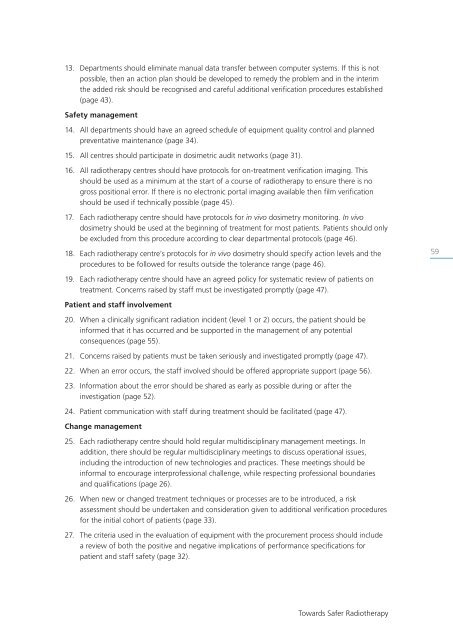Towards Safer Radiotherapy
Towards Safer Radiotherapy
Towards Safer Radiotherapy
You also want an ePaper? Increase the reach of your titles
YUMPU automatically turns print PDFs into web optimized ePapers that Google loves.
13. Departments should eliminate manual data transfer between computer systems. If this is not<br />
possible, then an action plan should be developed to remedy the problem and in the interim<br />
the added risk should be recognised and careful additional verification procedures established<br />
(page 43).<br />
Safety management<br />
14. All departments should have an agreed schedule of equipment quality control and planned<br />
preventative maintenance (page 34).<br />
15. All centres should participate in dosimetric audit networks (page 31).<br />
16. All radiotherapy centres should have protocols for on-treatment verification imaging. This<br />
should be used as a minimum at the start of a course of radiotherapy to ensure there is no<br />
gross positional error. If there is no electronic portal imaging available then film verification<br />
should be used if technically possible (page 45).<br />
17. Each radiotherapy centre should have protocols for in vivo dosimetry monitoring. In vivo<br />
dosimetry should be used at the beginning of treatment for most patients. Patients should only<br />
be excluded from this procedure according to clear departmental protocols (page 46).<br />
18. Each radiotherapy centre’s protocols for in vivo dosimetry should specify action levels and the<br />
procedures to be followed for results outside the tolerance range (page 46).<br />
59<br />
19. Each radiotherapy centre should have an agreed policy for systematic review of patients on<br />
treatment. Concerns raised by staff must be investigated promptly (page 47).<br />
Patient and staff involvement<br />
20. When a clinically significant radiation incident (level 1 or 2) occurs, the patient should be<br />
informed that it has occurred and be supported in the management of any potential<br />
consequences (page 55).<br />
21. Concerns raised by patients must be taken seriously and investigated promptly (page 47).<br />
22. When an error occurs, the staff involved should be offered appropriate support (page 56).<br />
23. Information about the error should be shared as early as possible during or after the<br />
investigation (page 52).<br />
24. Patient communication with staff during treatment should be facilitated (page 47).<br />
Change management<br />
25. Each radiotherapy centre should hold regular multidisciplinary management meetings. In<br />
addition, there should be regular multidisciplinary meetings to discuss operational issues,<br />
including the introduction of new technologies and practices. These meetings should be<br />
informal to encourage interprofessional challenge, while respecting professional boundaries<br />
and qualifications (page 26).<br />
26. When new or changed treatment techniques or processes are to be introduced, a risk<br />
assessment should be undertaken and consideration given to additional verification procedures<br />
for the initial cohort of patients (page 33).<br />
27. The criteria used in the evaluation of equipment with the procurement process should include<br />
a review of both the positive and negative implications of performance specifications for<br />
patient and staff safety (page 32).<br />
<strong>Towards</strong> <strong>Safer</strong> <strong>Radiotherapy</strong>



